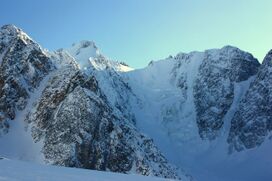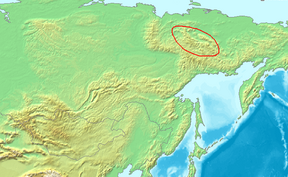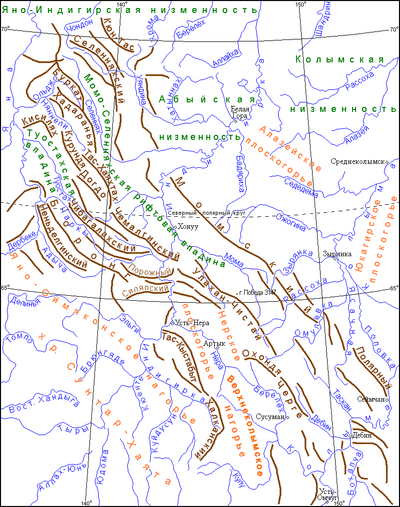سلسلة جبال تشرسكي
| سلسلة جبال تشرسكي | |
|---|---|
 View of Pobeda (Victory) Peak, highest point of the range. | |
| أعلى نقطة | |
| القمة | Pobeda |
| الارتفاع | 3،003 متر (9،852 ft) |
| الإحداثيات | 64°44′N 142°58′E / 64.733°N 142.967°E |
| الأبعاد | |
| الطول | 1،500 km (930 mi) NW/SE |
| العرض | 400 km (250 mi) NE/SW |
| الجغرافيا | |
| البلد | |
| Republic / Oblast | Sakha and Magadan |
| السلسلة الأم | East Siberian System |
| الجيولوجيا | |
| عمر الصخر | Precambrian, Permian, Triassic and Jurassic |
| نوع الصخر | Schist, sandstone, siltstone and Granite intrusive rocks |
The Chersky Range (روسية: Хребет Черского, بالياقوتية: Черскэй хайалара) is a chain of mountains in northeastern Siberia between the Yana and Indigirka Rivers. Administratively, the area of the range belongs to the Sakha Republic, although a small section in the east is within Magadan Oblast. The highest peak in the range is the 3،003-متر (9،852 ft)-tall Peak Pobeda, part of the Ulakhan-Chistay Range. The range also includes important places of traditional Yakut culture, such as Ynnakh Mountain (Mat'-Gora) and kigilyakh rock formations.[1]
The Moma Natural Park is a protected area located in the southern zone of the range.[2]
التاريخ
At some time between 1633 and 1642, Poznik Ivanov ascended a tributary of the lower Lena, crossed the Verkhoyansk Range to the upper Yana, and then crossed the Chersky Range to the Indigirka.[3] The range was sighted in 1926 by Sergei Obruchev (Vladimir Obruchev's son) and named by the Russian Geographical Society after the Lithuanian explorer and geographer Ivan Chersky (or Jan Czerski).[4]
الجغرافيا
 Kyundyulyun, the northernmost spur of the Chersky Range on the right bank of the Yana near Ust-Kuyga. |

The geographic boundaries of the mountain system are the Yana–Oymyakon Highlands in the southwest, the Upper Kolyma Highlands in the southeast, and the Momo-Selennyakh Depression in the northeast.[5]
السلاسل الفرعية
The system of the Chersky Range comprises a number of subranges running generally from northwest to southeast, including the following:
Between the Yana and Indigirka rivers:
- Burkat Range, highest point 1،150 متر (3،770 ft)
- Khadaranya Range, highest point 2،185 متر (7،169 ft)
- Ymiysky Range, highest point 1،048 متر (3،438 ft)
- Kisilyakh Range, highest point 1،548 متر (5،079 ft), by the confluence of the Adycha and the Yana
- Tas-Khayakhtakh, highest point 2،356 متر (7،730 ft)
- Kurundya Range, highest point 1،919 متر (6،296 ft)
- Dogdo Range, highest point 2،272 متر (7،454 ft)
- Chemalgin Range, highest point 2،547 متر (8،356 ft)
- Yana-Oymyakon Highlands
- Elgi Plateau (Эльгинское плоскогорье), highest point 1،590 متر (5،220 ft)
- Oymyakon Plateau, highest point 1،400 متر (4،600 ft)
- Yana Plateau, highest point 1،770 متر (5،810 ft)
- Tirekhtyakh Range and Nelgesin Range, between the Adycha and Sartang rivers
In the upper Kolyma river basin:
- Ulakhan-Chistay, highest point 3،003 متر (9،852 ft), near the southern end
- Okhandya Range, highest point 2،337 متر (7،667 ft), the highest point of Magadan Oblast.[6]
- Cherge Range, highest point 2،332 متر (7،651 ft)
- Angachak Range, highest point 2،293 متر (7،523 ft)
- Arga-Tas, highest point 2،400 متر (7،900 ft)
Between the Chibagalakh and Adycha rivers
- Chibagalakh Range, highest point 2،449 متر (8،035 ft)
- Onyol Range (Онёлский хребет), highest point 2،328 متر (7،638 ft)
- Borong Range, highest point 2،681 متر (8،796 ft) (west of the Charky)
- Nendelgin Range, highest point 1،777 متر (5،830 ft) (east of the Adycha)[7]
- Porozhny Range, highest point 2،551 متر (8،369 ft)
- Silyap Range, highest point Mount Chyon (Гора Чён) 2،690 متر (8،830 ft)[8]
Between the Indigirka and the Nera rivers:
- Tas-Kystabyt, highest point 2،341 متر (7،680 ft)
- Khalkan Range, highest point 1،615 متر (5،299 ft), a southern prolongation of Tas-Kystabyt
Northeastern outliers
In some works, a few roughly-parallel ranges located off the main system to the northeast, such as the Kyun-Tas Range (highest point 1،242 متر (4،075 ft)), the Selennyakh Range (highest point highest point Saltag-Tas (2،021 متر (6،631 ft)), and the adjacent Moma Range (highest point 2،533 متر (8،310 ft)), with the Moma-Selennyakh Depression running along their western side, are included in the Chersky mountain system.[9]
Other ranges of the system include the Irgichin Range, Inyalin Range, Volchan Range, Silen Range, and Polyarny Range, among others.[10]
الهيدروجرافيا
The Chersky System includes three main river basins:
- Yana River, covering the western and northwestern parts of the mountain system. It includes rivers Oldzho and Adycha with its tributaries Tuostakh and Charky.
- Indigirka River, covering the northeastern, central, and southwestern parts of the system, with rivers Selennyakh, Moma, and Nera, among others.
- Kolyma River, covering the eastern, southeastern, and southern parts of the system, with rivers Zyryanka, Rassokha, Omulyovka, Yasachnaya, Taskan, Debin, and Byoryolyokh, among others.
Some of the higher ranges with alpine relief have glaciers. There are roughly 350 glaciers in the system, with a total area of 156.2 km2 (60.3 sq mi).[11] There are also small lakes in the swampy valleys of some rivers, as well as lakes of glacial origin, such as Emanda and Tabanda.
التكتونيات
The range lies on the boundary between the Eurasian and North American tectonic plates.[12]
The precise nature of the boundary between the North American and Eurasian tectonic plates in the area of the Chersky Range is still not fully understood and is the subject of ongoing research. By the 1980s, the Chersky Range was considered mostly a zone of continental rifting where the crust was spreading apart.[13] However, the current[when?] view is that the Chersky Range is mostly an active suture zone, a continental convergent plate boundary, where compression is occurring as the two plates press against each other.[14] There is thought to be a point in the Chersky Range where the extensional forces coming from the north change to the compressional forces noted throughout most of the range. The Chersky Range is also thought to include a geologic triple junction where the Ulakhan Fault intersects the suture zone. Whatever the exact nature of the regional tectonics, the Chersky Range is seismically active. It connects in the north with the landward extension of the Laptev Sea Rift, itself a continental extension of the Mid-Arctic Gakkel Ridge.
المناخ
The Chersky mountains, along with the neighboring Verkhoyansk Range, have a moderating effect on the climate of Siberia. The ridges obstruct west-moving air flows, decreasing the amount of snowfall in the plains to the west.
انظر أيضاً
المراجع
- ^ Кисиляхи
- ^ "Moma Natural Park Official site". Archived from the original on 2019-09-29. Retrieved 2019-11-07.
- ^ G. Patrick March,'Eastern Destiny:Russia in Asia and the North Pacific, 1996, chapter 3
- ^ Obruchev, S. (1927). "Discovery of a Great Range in North-East Siberia". The Geographical Journal. 70 (5): 464–470. Bibcode:1927GeogJ..70..464O. doi:10.2307/1783479. JSTOR 1783479.
- ^ Хребет Черского (in Russian)
- ^ "БЕЗЫМЯННАЯ ВЕРШИНА НА ХРЕБТЕ ОХАНДЯ СТАЛА САМОЙ ВЫСОКОЙ ТОЧКОЙ МАГАДАНСКОЙ ОБЛАСТИ". Archived from the original on 2021-12-27. Retrieved 2021-12-27.
- ^ "Q-53_54 Chart (in Russian)". Retrieved 12 May 2023.
- ^ Массив Чен
- ^ Chersky Range // Great Russian Encyclopedia : [in 35 vols.] / Ch. ed. Yu.S. Osipov . - M , 2004—2017.
- ^ Oleg Leonidovič Kryžanovskij, A Checklist of the Ground-beetles of Russia and Adjacent Lands. p. 15
- ^ Черского хребет (в Якутской АССР и Магаданской обл.), Great Soviet Encyclopedia
- ^ News Archive – The Earth Institute at Columbia University
- ^ "Geodynamics and Late Cenozoic Evolution of the Asia/Pacific Transitional Zone", in Tectonics, International Geological Congress Staff, 27th International Geological Congress, Published 1984 by VSP
- ^ The Physical Geography of Northern Eurasia, ed. Maria Shahgedanova, published by Oxford University Press 2003
وصلات خارجية
- Pages using gadget WikiMiniAtlas
- Short description is different from Wikidata
- Coordinates on Wikidata
- Articles containing روسية-language text
- Pages using Lang-xx templates
- Articles containing Yakut-language text
- Vague or ambiguous time from May 2024
- سلسلة جبال تشرسكي
- تكتونيات الصفائح
- Tourist attractions in the Sakha Republic
- جبال سيبيريا الشرقية

